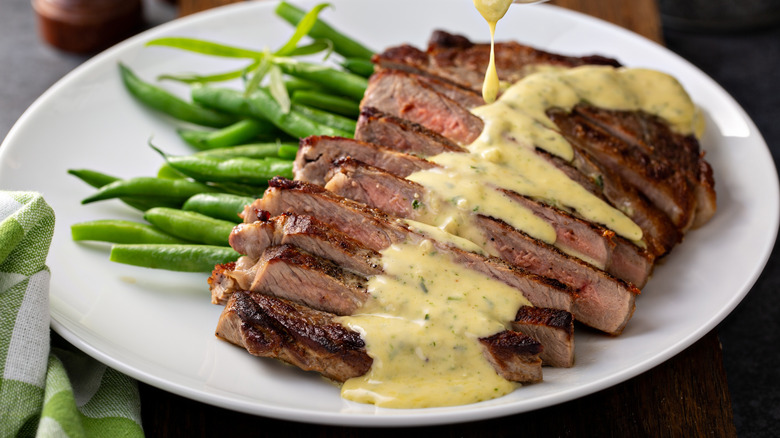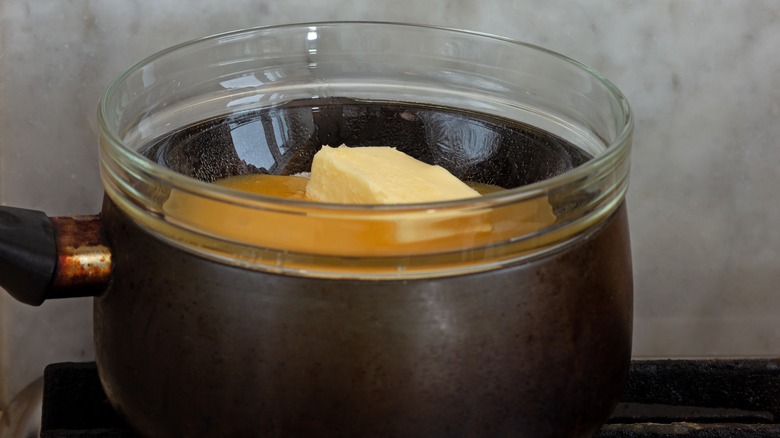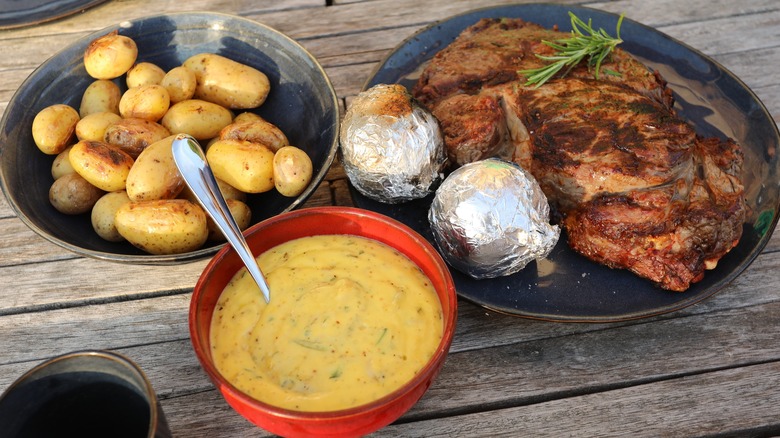The Crucial Step You Shouldn't Forget When Making Béarnaise Sauce
If you're going for that classic steakhouse quality meal at home, then you're going to need béarnaise sauce. There are plenty of secrets that steakhouses use to elevate their meal, and unfortunately, you won't be able to copy all of them. However, one that you can easily copy at home is to pair your filet mignon or t-bone with a heaping serving of béarnaise sauce.
According to The New York Times, béarnaise sauce is an off-shoot of hollandaise sauce. That rich creamy magic that makes eggs benedict a brunch staple is what's known as a "mother sauce" in French cuisine. That means that it can serve as the base for a variety of different sauces, per Food52. The key difference between these two is the way that they are flavored. MasterClass points out that Béarnaise gets its signature tang from a white wine vinegar reduction flavored with shallots and tarragon.
That acidity helps cut through the fat of a good steak, and it makes the sauce an essential side to have on hand if you're emulating the nation's top steakhouses.
Classic way to make béarnaise sauce
Making béarnaise can be a difficult task. As RecipeTin Eats points out, the dish requires very carefully cooking egg yolks, and creating an emulsification between the vinegar, butter, and yolks. You can easily end up with scrambled eggs, separated components, or a runny and unappetizing sauce if you don't take your time over the stove.
There are a few ways that well-seasoned chefs manage to nail the béarnaise every time. For example, MasterClass recommends preparing the ingredients directly over a carefully managed stove. Other components are added one at a time, and bit-by-bit while whisking constantly to ensure a proper emulsification. This method requires heavy whisking, and a steady hand on the stove dial to ensure that it turns out correctly.
One way to help alleviate some of this culinary stress is to use a double boiler. WebstaurantStore says that a double boiler uses a bowl set over a pan of boiling water to use the gentle heat of steam as a cooking medium. The New York Times uses this method to initially fluff up the egg yolks without them curdling, and it helps with the emulsification as well.
If all of this sounds like too much work, there is another option that takes some of the hassles out of making béarnaise.
Making béarnaise with a blender
One way to simplify the béarnaise preparation process is to use a blender. Food & Wine's Justin Chapple uses a blender to take some of the work out of the emulsification process. No need for heavy whisking when your blender is doing all the work. Instead, you'll just simply add the vinegar reduction and butter a little at a time to the egg yolks being whipped around the blender.
The most crucial step to remember with this method though is that you must heat your blender. That's right, even with a simplified method, you'll still need to worry about controlling your temperature. Food & Wine says that this is to keep the butter from seizing up when it's added to the mixture later.
All you need to do to heat the blender's pitcher is to fill it with some warm water just before putting it to work. Then, just dump out the water, and wipe out the interior with a towel to remove any excess moisture.


